Real–Sim–Real Transfer for Real-World Robot Control Policy Learning with Deep Reinforcement Learning †
Abstract
1. Introduction
- (1)
- We present a new learning paradigm to train control policies for real-world robots with the DRL method. The learning pipeline is divided into a real-to-sim training phase and a sim-to-real inference phase, which trains robot control policy with a higher generalization capability and lower costs.
- (2)
- The proposed method automatically constructs a task-relevant simulated environment for policy learning based on semantic information of real-world working scenarios and coordinate transformation, which avoids the challenging problem of manually creating the simulated environments with high fidelity, endowing the policy learning process with high efficiency.
- (3)
- The proposed method directly employs the trained policy in real-world scenarios without any real-world training data or fine-tuning.
2. Related Work
2.1. Robot Control Policy Learning
2.2. Sim-to-Real Transfer
3. Method
3.1. Generating a Simulated Environment
3.2. Policy Network
3.3. Policy Training
3.4. Deploying the Trained Policy
3.5. Performance Evaluation
| Algorithm 1 RSR transfer method |
| Real-to-sim training phase: |
|
| Sim-to-real inference phase: |
|
4. Experiments and Results
4.1. Semantic Segmentation of Robot Working Scenarios
4.2. Policy Learning
- (1)
- Transfer-RGB: direct training policy with simulated RGB images and using real-world RGB images in the inference period.
- (2)
- Transfer-Depth: training policy with simulated depth images and using real-world depth images in the inference period.
- (3)
- DR (domain randomization): In the policy training period, the mesh of the objects in the simulated environment is randomly chosen from 50 textures. The camera position and orientation remain fixed, which matches the real-world scenario. The trained policy is directly employed in the real-world scenario in the policy inference period.
- (4)
- DA (domain adaptation): First, the training policy is implemented in the simulated environment and then the trained policy is fine-tuned using the same amount of real-world training data as in the simulated environment.
5. Conclusions
Author Contributions
Funding
Conflicts of Interest
References
- Liu, N.; Lu, T.; Cai, Y.; Wang, S. A Review of Robot Manipulation Skills Learning Methods. Acta Autom. Sin. 2019, 45, 458–470. [Google Scholar]
- Bohg, J.; Morales, A.; Asfour, T.; Kragic, D. Data-Driven Grasp Synthesis: A Survey. IEEE Trans. Robot. 2014, 30, 289–309. [Google Scholar] [CrossRef]
- Goldfeder, C.; Allen, P.K.; Lackner, C.; Pelossof, R. Grasp planning via decomposition trees. In Proceedings of the IEEE International Conference on Robotics and Automation, Roma, Italy, 10–14 April 2007; pp. 4679–4684. [Google Scholar]
- Arulkumaran, K.; Deisenroth, M.P.; Brundage, M.; Bharath, A.A. Deep reinforcement learning: A brief survey. IEEE Signal Process. Mag. 2017, 34, 26–38. [Google Scholar] [CrossRef]
- Sutton, R.S.; Barto, A.G. Reinforcement Learning: An Introduction; MIT Press: Cambridge, MA, USA, 1998. [Google Scholar]
- Mnih, V.; Kavukcuoglu, K.; Silver, D.; Rusu, A.A.; Veness, J.; Bellemare, M.G.; Graves, A.; Riedmiler, M.; Fidjeland, A.K.; Ostrovski, G.; et al. Human-level control through deep reinforcement learning. Nature 2015, 518, 529–533. [Google Scholar] [CrossRef] [PubMed]
- Silver, D.; Schrittwieser, J.; Simonyan, K.; Antonoglou, I.; Huang, A.; Guez, A.; Hubert, T.; Baker, L.; Lai, M.; Bolton, A.; et al. Mastering the game of Go without human knowledge. Nature 2017, 550, 354–359. [Google Scholar] [CrossRef] [PubMed]
- Kroemer, O.; Niekum, S.; Konidaris, G. A Review of Robot Learning for Manipulation: Challenges, Representations, and Algorithms. arXiv 2019, arXiv:1907.03146. [Google Scholar]
- Tobin, J.; Fong, R.; Ray, A.; Schneider, J.; Zaremba, W.; Abbeel, P. Domain randomization for transferring deep neural networks from simulation to the real world. In Proceedings of the IEEE/RSJ International Conference on Intelligent Robots and Systems, Vancouver, BC, Canada, 24–28 September 2017; pp. 23–30. [Google Scholar]
- Zhang, J.; Tai, L.; Yun, P.; Xiong, Y.; Liu, M.; Boedecker, J.; Burgard, W. Vr-goggles for robots: Real-to-sim domain adaptation for visual control. IEEE Robot. Autom. Lett. 2019, 4, 1148–1155. [Google Scholar] [CrossRef]
- Calinon, S.; Dhalluin, F.; Sauser, E.; Caldwell, D.; Billard, A. Learning and Reproduction of Gestures by Imitation. IEEE Robot. Autom. Mag. 2010, 17, 44–54. [Google Scholar] [CrossRef]
- Zhang, T.; McCarthy, Z.; Jow, O.; Lee, D.; Chen, X.; Goldberg, K.; Abbeel, P. Deep Imitation Learning for Complex Manipulation Tasks from Virtual Reality Teleoperation. In Proceedings of the IEEE International Conference on Robotics and Automation, Brisbane, QLD, Australia, 21–25 May 2018; pp. 5628–5635. [Google Scholar]
- Rahmatizadeh, R.; Abolghasemi, P.; Behal, A.; Boloni, L. From virtual demonstration to real-world manipulation using LSTM and MDN. In Proceedings of the AAAI Conference on Artificial Intelligence, New Orleans, Louisiana, USA, 2–7 February 2018; pp. 6524–6531. [Google Scholar]
- Codevilla, F.; Miiller, M.; Lopez, A.; Koltun, V.; Dosovitskiy, A. End-to-End Driving Via Conditional Imitation Learning. In Proceedings of the IEEE International Conference on Robotics and Automation, Brisbane, QLD, Australia, 21–25 May 2018; pp. 4693–4700. [Google Scholar]
- Ross, S.; Melik-Barkhudarov, N.; Shankar, K.S.; Wendel, A.; Dey, D.; Bagnell, J.A.; Hebert, M. Learning monocular reactive UAV control in cluttered natural environments. In Proceedings of the 2013 IEEE International Conference on Robotics and Automation, Karlsruhe, Germany, 6–10 May 2013; pp. 1765–1772. [Google Scholar]
- Levine, S.; Pastor, P.; Krizhevsky, A.; Ibarz, J.; Quillen, D. Learning hand-eye coordination for robotic grasping with deep learning and large-scale data collection. Int. J. Rob. Res. 2018, 37, 421–436. [Google Scholar] [CrossRef]
- Pinto, L.; Gupta, A. Supersizing self-supervision: Learning to grasp from 50K tries and 700 robot hours. In Proceedings of the 2016 IEEE International Conference on Robotics and Automation, Stockholm, Sweden, 16–21 May 2016; pp. 3406–3413. [Google Scholar]
- Stulp, F.; Theodorou, E.A.; Schaal, S. Reinforcement Learning With Sequences of Motion Primitives for Robust Manipulation. IEEE Trans. Robot. 2012, 28, 1360–1370. [Google Scholar] [CrossRef]
- Duguleana, M.; Barbuceanu, F.G.; Teirelbar, A.; Mogan, G. Obstacle avoidance of redundant manipulators using neural networks based reinforcement learning. Robot. Comput. Integr. Manuf. 2012, 28, 132–146. [Google Scholar] [CrossRef]
- Althoefer, K.; Krekelberg, B.; Husmeier, D.; Seneviratne, L. Reinforcement learning in a rule-based navigator for robotic manipulators. Neurocomputing 2001, 37, 51–70. [Google Scholar] [CrossRef]
- Miljkovic, Z.; Mitic, M.; Lazarevic, M.; Babic, B. Neural network reinforcement learning for visual control of robot manipulators. Expert Syst. Appl. 2013, 40, 1721–1736. [Google Scholar] [CrossRef]
- Kakas, A.C.; Cohn, D.; Dasgupta, S.; Barto, A.G.; Carpenter, G.A.; Grossberg, S. Autonomous Helicopter Flight Using Reinforcement Learning. In Encyclopedia of Machine Learning; Springer: Boston, MA, USA, 2011; pp. 53–61. [Google Scholar]
- Kormushev, P.; Calinon, S.; Caldwell, D.G. Reinforcement learning in robotics: Applications and real-world challenges. Robotics 2013, 3, 122–148. [Google Scholar] [CrossRef]
- Kober, J.; Bagnell, J.A.; Peters, J. Reinforcement learning in robotics: A survey. Int. J. Rob. Res. 2013, 32, 1238–1274. [Google Scholar] [CrossRef]
- Zhang, F.; Leitner, J.; Milford, M.; Upcroft, B.; Corke, P. Towards Vision-Based Deep Reinforcement Learning for Robotic Motion Control. In Proceedings of the Australasian Conference on Robotics and Automation, Canberra, Australia, 2–4 December 2015. [Google Scholar]
- Zhang, F.; Leitner, J.; Milford, M.; Corke, P. Modular deep q networks for sim-to-real transfer of visuo-motor policies. In Proceedings of the Australasian Conference on Robotics and Automation, Sydney, Australia, 11–13 December 2017. [Google Scholar]
- Silver, D.; Lever, G.; Heess, N.; Degris, T.; Wierstra, D.; Riedmiller, M. Deterministic policy gradient algorithms. In Proceedings of the International Conference on Machine Learning, Beijing, China, 21–26 June 2014; pp. 387–395. [Google Scholar]
- Schulman, J.; Levine, S.; Moritz, P.; Jordan, M.I.; Abbeel, P. Trust Region Policy Optimization. In Proceedings of the International Conference on Machine Learning, Lille, France, 6–11 July 2015; pp. 1889–1897. [Google Scholar]
- Mnih, V.; Badia, A.P.; Mirza, M.; Graves, A.; Harley, T.; Lillicrap, T.P.; Silver, D.; Kavukcuoglu, K. Asynchronous methods for deep reinforcement learning. In Proceedings of the International Conference on Machine Learning, New York, NY, USA, 19–24 June 2016; pp. 1928–1937. [Google Scholar]
- Schulman, J.; Moritz, P.; Levine, S.; Jordan, M.; Abbeel, P. High-dimensional continuous control using generalized advantage estimation. arXiv 2015, arXiv:1506.02438. [Google Scholar]
- Schulman, J.; Wolski, F.; Dhariwal, P.; Radford, A.; Klimov, O. Proximal policy optimization algorithms. arXiv 2017, arXiv:1707.06347. [Google Scholar]
- Levine, S.; Finn, C.; Darrell, T.; Abbeel, P. End-to-end training of deep visuomotor policies. J. Mach. Learn. Res. 2016, 17, 1334–1373. [Google Scholar]
- Stephen, J.; Edward, J. 3d simulation for robot arm control with deep q-learning. In NIPS 2016 Workshop: Deep Learning for Action and Interaction. arXiv 2016, arXiv:1609.03759. [Google Scholar]
- Mahler, J.; Liang, J.; Niyaz, S.; Laskey, M.; Doan, R.; Liu, X.; Ojea, J.A.; Goldberg, K. Dex-net 2.0: Deep learning to plan robust grasps with synthetic point clouds and analytic grasp metrics. arXiv 2017, arXiv:1703.09312. [Google Scholar]
- Viereck, U.; Pas, A.; Saenko, K.; Platt, R. Learning a visuomotor controller for real world robotic grasping using simulated depth images. arXiv 2017, arXiv:1706.04652. [Google Scholar]
- Fang, K.; Bai, Y.; Hinterstoisser, S.; Savarese, S.; Kalakrishnan, M. Multi-task domain adaptation for deep learning of instance grasping from simulation. In Proceedings of the IEEE International Conference on Robotics and Automation, Brisbane, QLD, Australia, 21–25 May 2018; pp. 3516–3523. [Google Scholar]
- Stein, G.J.; Roy, N. Genesis-rt: Generating synthetic images for training secondary real-world tasks. In Proceedings of the IEEE International Conference on Robotics and Automation, Brisbane, QLD, Australia, 21–25 May 2018; pp. 7151–7158. [Google Scholar]
- Cutler, M.; How, J.P. Efficient reinforcement learning for robots using informative simulated priors. In Proceedings of the IEEE International Conference on Robotics and Automation, Washington, DC, USA, 26–30 May 2015; pp. 2605–2612. [Google Scholar]
- Bousmalis, K.; Irpan, A.; Wohlhart, P.; Bai, Y.; Kelcey, M.; Kalakrishnan, M.; Downs, L.; Ibraz, J.; Pastor, P.; Konolige, K.; et al. Using simulation and domain adaptation to improve efficiency of deep robotic grasping. In Proceedings of the IEEE International Conference on Robotics and Automation, Brisbane, QLD, Australia, 21–25 May 2018; pp. 4243–4250. [Google Scholar]
- Rusu, A.A.; Vecerik, M.; Rothorl, T.; Heess, N.; Pascanu, R.; Hadsell, R. Sim-to-Real Robot Learning from Pixels with Progressive Nets. In Proceedings of the 1st Conference on Robot Learning, Mountain View, CA, USA, 13–15 November 2017; pp. 262–270. [Google Scholar]
- Sadeghi, F.; Levine, S. CAD2RL: Real Single-Image Flight Without a Single Real Image. In Proceedings of the Robotics: Science and Systems XIII; Robotics: Science and Systems Foundation, Cambridge, MA, USA, 12–16 July 2017. [Google Scholar]
- Zhu, Y.; Wang, Z.; Merel, J.; Rusu, A.; Erez, T.; Cabi, S.; Tunyasuvunakool, S.; Kramar, J.; Hadsell, R.; de Feritas, N.; et al. Reinforcement and Imitation Learning for Diverse Visuomotor Skills. In Proceedings of the Robotics: Science and Systems XIV, Robotics: Science and Systems Foundation, PA, USA, 26–30 June 2018. [Google Scholar]
- Peng, X.B.; Andrychowicz, M.; Zaremba, W.; Abbeel, P. Sim-to-Real Transfer of Robotic Control with Dynamics Randomization. In Proceedings of the IEEE International Conference on Robotics and Automation, Brisbane, QLD, Australia, 21–25 May 2018; pp. 3803–3810. [Google Scholar]
- Yan, M.; Frosio, I.; Tyree, S.; Kautz, J. Sim-to-Real Transfer of Accurate Grasping with Eye-In-Hand Observations and Continuous Control, Neural Information Processing Systems (NIPS) Workshop on Acting and Interacting in the Real World: Challenges in Robot Learning. arXiv 2017, arXiv:1712.03303. [Google Scholar]
- Zhang, F.; Leitner, J.; Milford, M.; Corke, P.I. Sim-to-real transfer of visuo-motor policies for reaching in clutter: Domain randomization and adaptation with modular networks. arXiv 2017, arXiv:1709.05746. [Google Scholar]
- Shelhamer, E.; Long, J.; Darrell, T. Fully convolutional networks for semantic segmentation. IEEE Trans. Pattern Anal. Mach. Intell. 2017, 39, 640–651. [Google Scholar] [CrossRef]
- Simonyan, K.; Zisserman, A. Very deep convolutional networks for large-scale image recognition. In Proceedings of the International Conference on Learning Representations, San Diego, CA, USA, 7–9 May 2015. [Google Scholar]
- Todorov, E.; Erez, T.; Tassa, Y. MuJoCo: A physics engine for model-based control. In Proceedings of the IEEE/RSJ International Conference on Intelligent Robots and Systems, Algarve, Portugal, 7–12 October 2012; pp. 5026–5033. [Google Scholar]
- Brockman, G.; Cheung, V.; Pettersson, L.; Schneider, J.; Schulman, J.; Tang, J.; Zaremba, W. Openai gym. arXiv 2016, arXiv:1606.01540. [Google Scholar]
- Kingma, D.P.; Ba, J. Adam: A method for stochastic optimization. arXiv 2014, arXiv:1412.6980. [Google Scholar]
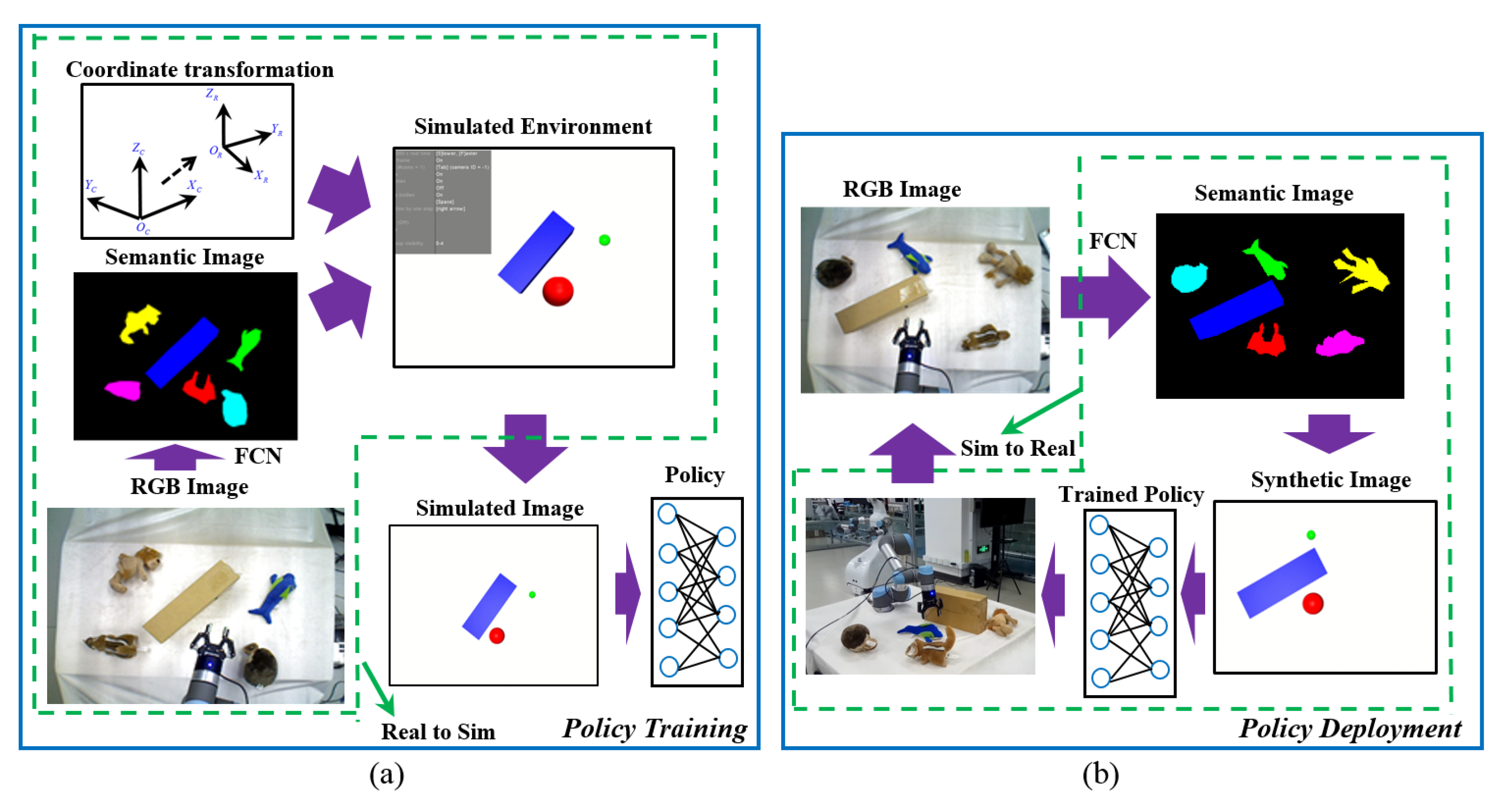




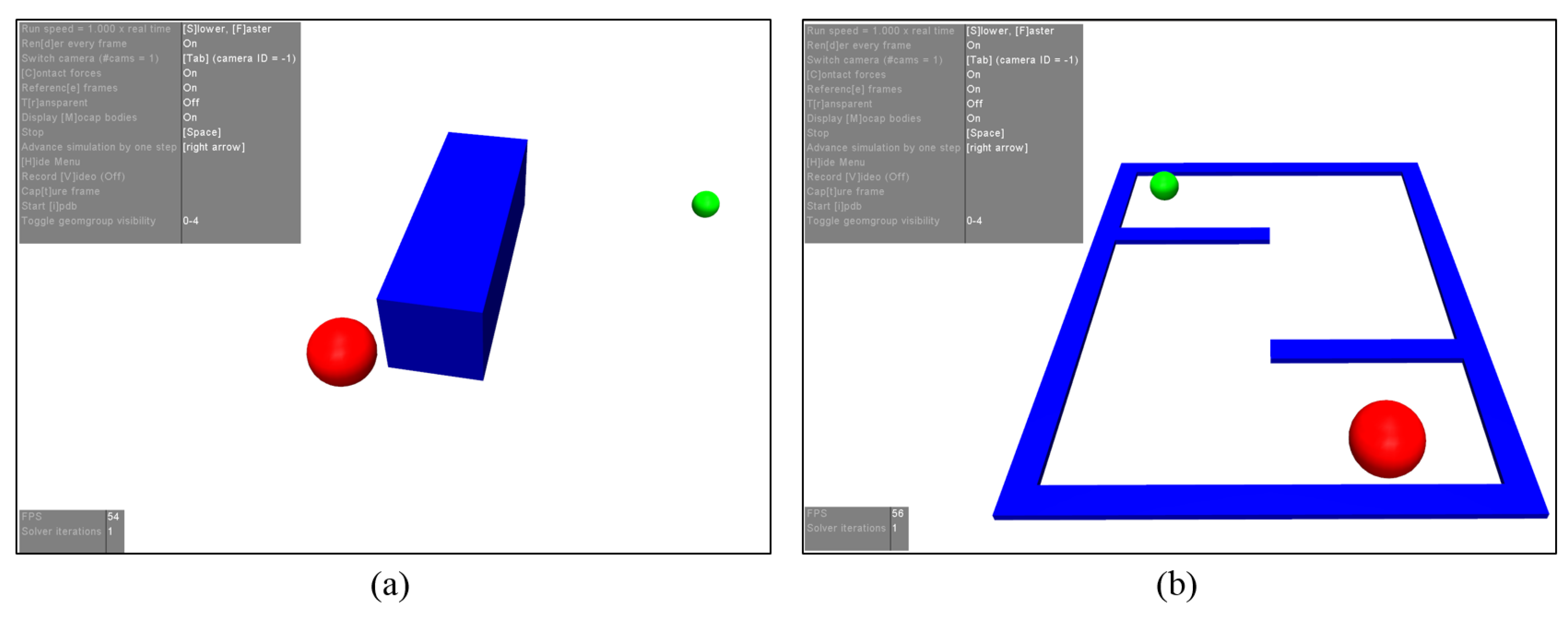
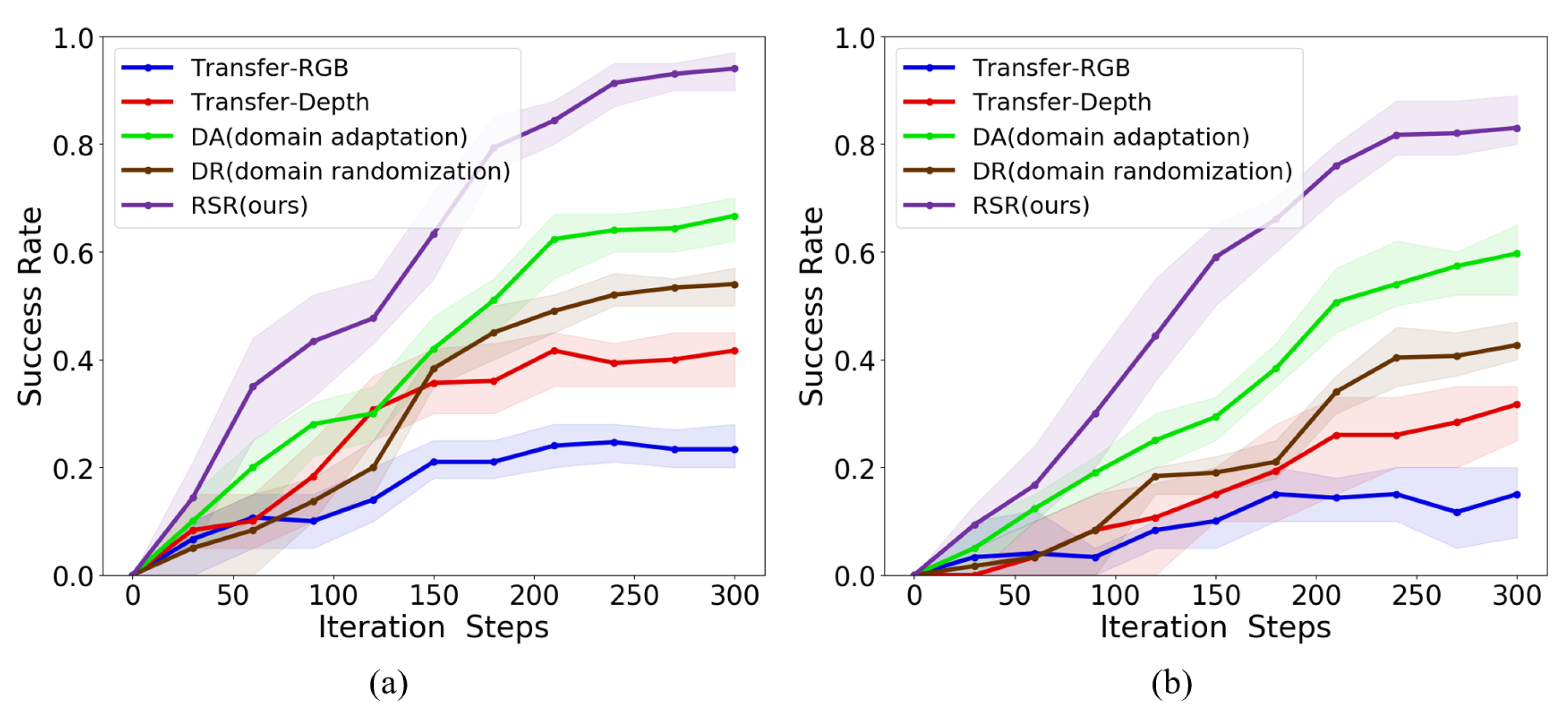
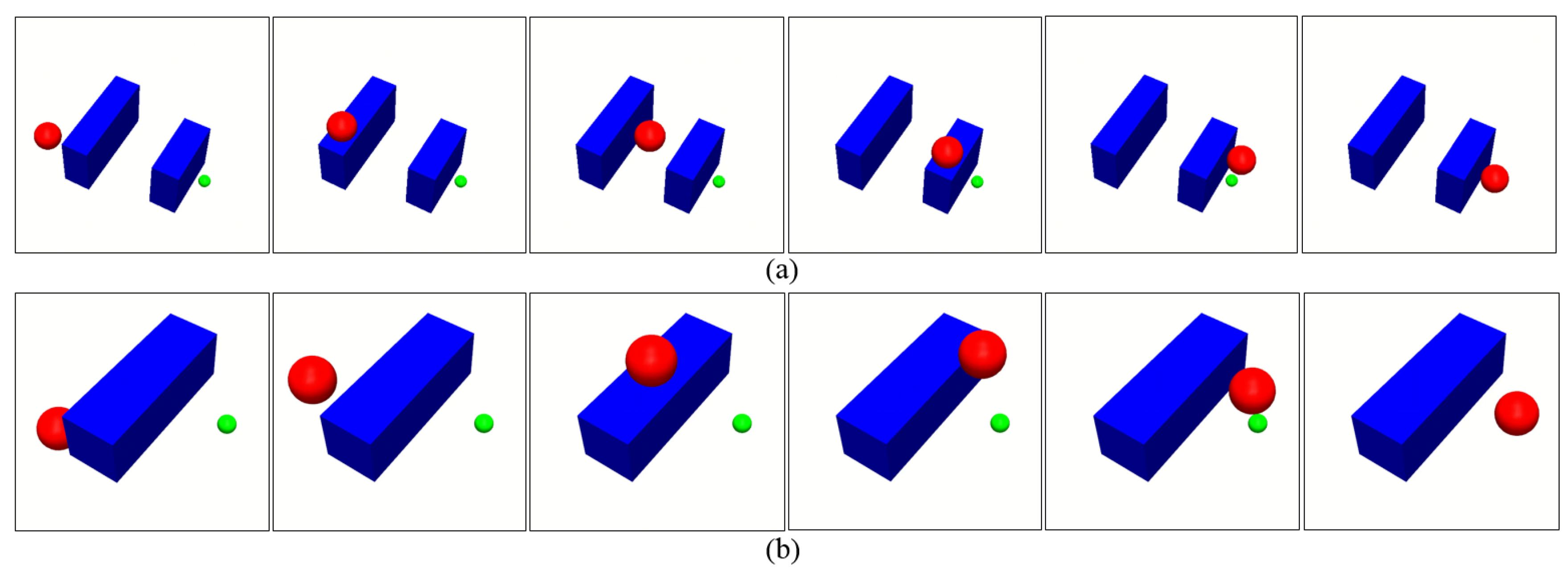
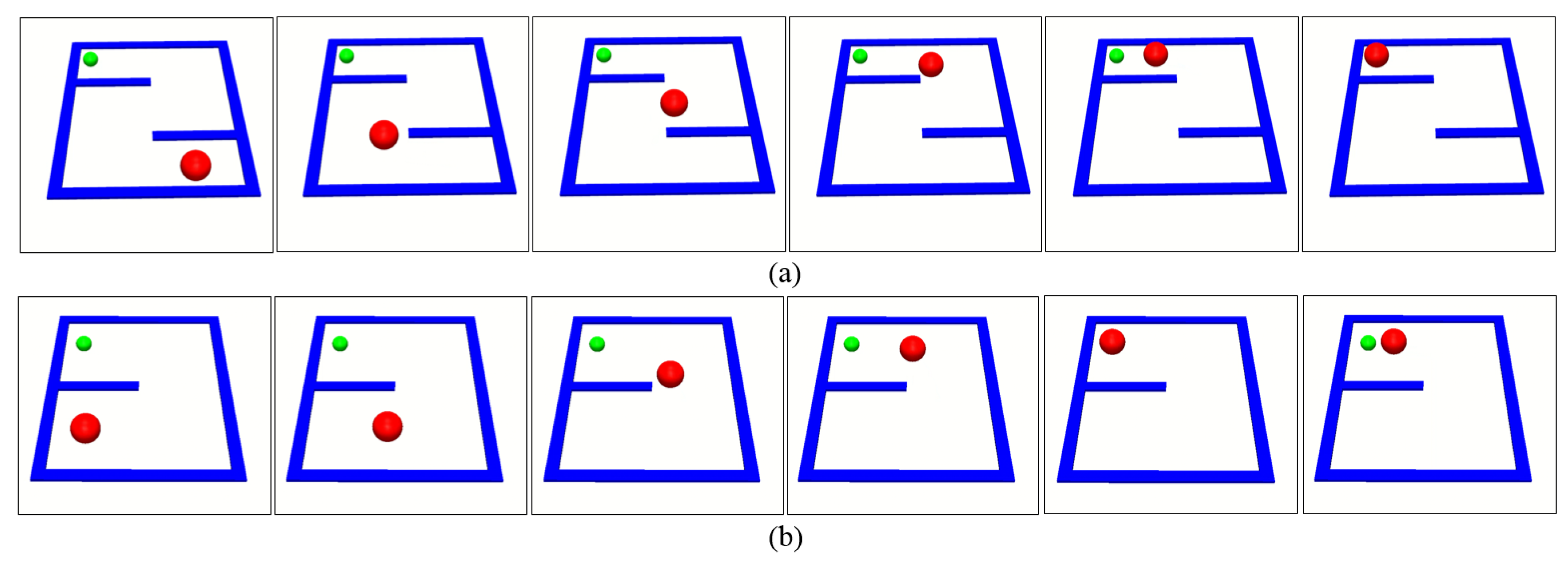


| Parameter | Value |
|---|---|
| Learning rate for policy | |
| Learning rate for value function | |
| Length of horizon T | 100 (Manipulation); 200 (Navigation) |
| Discount | 0.99 |
| Rollouts per iteration | 20 |
| Batch size | 32 |
| Optimization method | Adam [50] |
| Methods | Manipulation Task | Navigation Task |
|---|---|---|
| Transfer-RGB | ||
| Transfer-Depth | ||
| DR (domain randomization) | ||
| DA (domain adaptation) | ||
| RSR(ours) |
© 2020 by the authors. Licensee MDPI, Basel, Switzerland. This article is an open access article distributed under the terms and conditions of the Creative Commons Attribution (CC BY) license (http://creativecommons.org/licenses/by/4.0/).
Share and Cite
Liu, N.; Cai, Y.; Lu, T.; Wang, R.; Wang, S. Real–Sim–Real Transfer for Real-World Robot Control Policy Learning with Deep Reinforcement Learning. Appl. Sci. 2020, 10, 1555. https://doi.org/10.3390/app10051555
Liu N, Cai Y, Lu T, Wang R, Wang S. Real–Sim–Real Transfer for Real-World Robot Control Policy Learning with Deep Reinforcement Learning. Applied Sciences. 2020; 10(5):1555. https://doi.org/10.3390/app10051555
Chicago/Turabian StyleLiu, Naijun, Yinghao Cai, Tao Lu, Rui Wang, and Shuo Wang. 2020. "Real–Sim–Real Transfer for Real-World Robot Control Policy Learning with Deep Reinforcement Learning" Applied Sciences 10, no. 5: 1555. https://doi.org/10.3390/app10051555
APA StyleLiu, N., Cai, Y., Lu, T., Wang, R., & Wang, S. (2020). Real–Sim–Real Transfer for Real-World Robot Control Policy Learning with Deep Reinforcement Learning. Applied Sciences, 10(5), 1555. https://doi.org/10.3390/app10051555




